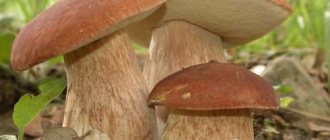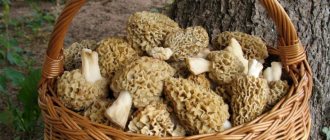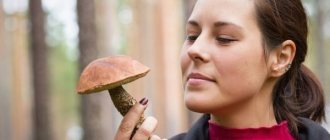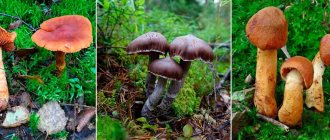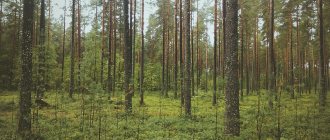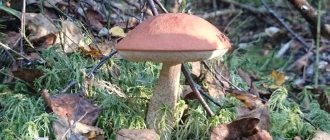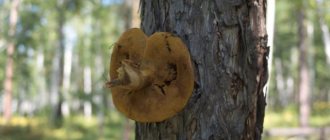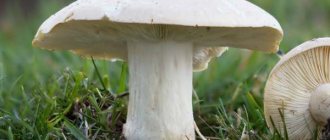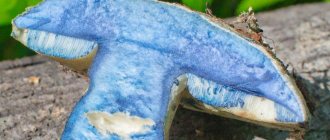Mushrooms
1
1999
Article rating
Kira Stoletova
It is better to collect mushrooms in the Samara region in the suburbs or in the regions of the province. Mushroom places in the Samara region are diverse, which is explained by the climate of the region.
Mushrooms of the Samara region
Mushroom places of the Samara region
On the territory of the region there are many very popular mushroom places, which are well known not only to experienced mushroom pickers, but also to novice lovers of “silent hunting” :
- Among the places richest in boletus, russula and black milk mushrooms is the area near the village of Krasny Yar;
- for honey mushrooms, as well as real milk mushrooms and chanterelles, you can safely go to the outskirts of the village of Pribrezhny in the Krasnoglinsky district;
- one of the favorite places for mushroom pickers is the coniferous forest belt, birch grove and linden plantings around the villages of Staraya Binaradka and Kurumoch;
- the surroundings of the village of Kanuevka, located in the Bezenchuksky district, abound in boletus, boletus and russula from early spring;
- in the forests around the village of Orlovka, Koshkinsky district, mushrooms such as boletus and boletus, as well as russula and pigweed, bear fruit en masse until autumn;
- mixed forests near the village of Malaya Malyshevka in the Kinelsky district are characterized by an abundance of boletus, boletus, aspen and black milk mushrooms;
- One of the very popular mushroom places is the village of Zaborovka in the Syzran region, in the vicinity of which you can collect honey mushrooms, tremors and boletus.
For many years, the most favorite place for mushroom pickers has been the territory of the national park or Buzuluksky Forest in the Samara Region, where almost all edible varieties bear fruit very abundantly and every year.
Honey mushrooms in the Southern Urals 2022
People living in the southern Urals know firsthand how many honey mushrooms can be collected from mid-summer to the end of winter. On the ground you can collect not only meadow, summer and autumn varieties, but also winter ones. Flammulina grows even under a layer of snow if there is no frost outside.
Over the years, residents of the region compare honey mushrooms to sunflower seeds. This is because the “silent hunt” is addictive, the mushrooms remain no less tasty, and their number only grows over the years. It’s not for nothing that people call these edible fruits “parasites.” Land infected with mycelium destroys berries, vegetables and perennial plants. Due to reproduction by spores, mushrooms are not planted in summer cottages and the territory of a private house.
Most often, honey mushrooms grow on trees, soil and stumps, less often - in areas bordering water.
It is not recommended to collect honey mushrooms on contaminated soil. Greed can lead to poisoning of the body with toxins. Factories, highways, cemeteries and their surrounding areas, landfills are forbidden territory!
Edible mushrooms of the Samara region
The region's climate is characterized by fairly cold winters with little snow, a short spring period, and hot and dry summers. The temperate continental climate and fairly fertile soils contribute to the good growth of the mycelium of various edible varieties of mushrooms:
- boletus or redhead , which forms mycorrhizas mainly with aspens, and somewhat less often with other deciduous tree species. A tubular variety of the second group in nutritional value, with a fleshy, spherical or pillow-shaped, yellowish-red, brownish-red or orange-red cap. The leg is straight and high, thickened at the base, white with a dark brown scaly pattern;
- boletus or birch grass , growing in birch groves or mixed forests. The tubular appearance is distinguished by a first spherical, and then flattened, whitish-brown, brownish-brown or dark brownish cap and a dense, slightly thin, slightly thickened in the lower part, covered with a blackish and often scaly pattern;
- oiler , belonging to the group of tubular mushrooms of the second category. It grows most often in pine plantations and spruce forests. It has a fleshy, semicircular, sometimes slimy, reddish-brown cap of light yellow color. A characteristic feature is the presence of a white ring-shaped film on the short stem;
- honey mushrooms from the group of lamellar fruiting bodies and belonging to the first category in terms of nutritional value, grow in whole groups, located on old decaying stumps and surface roots of trees. They have a round or somewhat outstretched cap of copper-brown or beige-brown color. The leg is thin and quite long.
Also in the category of edible and conditionally edible varieties, but with different indicators of nutritional value, are chanterelles, russula and valui, which are often found in the region, white and black milk mushrooms, as well as the “noble” and very valuable porcini mushroom or boletus.
Inedible and poisonous mushrooms of the Samara region
Varieties from the inedible category do not contain toxic substances, but have hard, too thin or bitter pulp with an unpleasant odor. Poisonous species pose the greatest danger to human life and health , so such mushrooms need to be carefully studied so as not to be confused with their edible counterparts.
- false honey fungus grows in whole groups, preferring decaying birch wood. Unlike edible mushrooms, it is smaller in size, has a thinner stem, and is also characterized by the absence of a film. The cap is rounded-flat, grayish-yellow in color, with a red spot in the central part;
- Russula emetic belongs to the common lamellar species and has a bright red cap, a very dense and strong pulp structure, and a fragile white stalk. The main difference from the edible marsh russula is the presence of a very hot, even acrid taste and the edges of the cap pressed to the stem in the youngest specimens;
Morel and line: what is the difference
Morel mushrooms are similar in appearance to strings, they can be easily confused, because they are members of the same mushroom family.
The body of the line looks like a brain or a walnut, the cap is shaped like a circle, but not quite regular and even in shape, diameter is 2-10 cm, the surface is velvety. Let us highlight the main distinguishing features of stitches and morels:
- taking a closer look, you can note that the morel cap, unlike its double, is shaped like a cone;
- Morchella are clearly visible above the ground, the stem is completely visible (the stem is hidden in the ground or foliage);
- when looking at mushrooms, you can notice that the edible double “reaches” to the sky (the cap and stem are elongated), the line, on the contrary, tends to the ground, the stem is short, the mushroom is squat;
- Morchella is empty in the middle, the line in the center has sinuous flesh;
- the lines are larger in size and have a less intense mushroom aroma than their edible brothers.
What does a line look like?
Where to collect honey mushrooms in the Samara region (video)
- The alder moth is an inedible species characterized by a low degree of toxicity. The fruiting bodies are very similar to edible honey mushrooms, and the main difference is that they grow on the stumps of exclusively deciduous wood. In addition to being durable, there are small scales on the outside of the cap;
- combed silverfish , which is a close relative of the poisonous combed umbrella, and is characterized by the presence of muscarinic poisons in the pulp, which accumulate in the human body. It is distinguished by the formation of a dome-shaped or saucer-shaped cap of a whitish-gray color, as well as a thin stalk. A sharp peppery smell and a red color appear on the cut.
Also among the inedible and poisonous species are the widespread pale grebe, fringed galerina, as well as panther, stinking, gray and red fly agarics.
Rare mushrooms of Samara
The varieties of mushrooms growing in the Samara region are, for the most part, quite typical for the central zone of our country. As a rule, here you can find the fruiting bodies of mole mushrooms, boletus and honey mushrooms, russula, chanterelles and sow mushrooms, milk mushrooms and valuuya, as well as various boletuses, boletus and boletus.
However, the soil is also favorable for other, rarer species, including the expensive truffle or Tuber aestivum. Also in the forests of the region you can sometimes find another basidial variety - the morel. Another very interesting and quite rare mushroom that grows in some places in the region is blackberry, which can be represented by orange, coral and notched varieties.
Advice from mushroom pickers in Samara
Forest zones occupy more than 12% of the total area of the region, so about two hundred edible and conditionally edible varieties of mushrooms grow here. It is advisable to go for mushrooms in the early morning hours , when the fruiting bodies are strongest and are easily transported. To collect mushrooms, you need to prepare wicker baskets in which the collected fruiting bodies are placed with the cap down.
It is best for novice mushroom pickers to “hunt” for tubular varieties, among which there are practically no toxic species. It is recommended to collect such mushrooms near the village of Volzhsky Utes or the village of Muranka, Shigonsky district. Milk mushrooms can be collected in the vicinity of the Vasilyevsky Islands, the villages of Kanuevka and Aleksandrovka, Bezenchuksky district. However, an inexperienced mushroom picker who is poorly versed in the types of mushrooms should be wary of the presence of white or colored milky juice, blue coloring on the cut, the presence of a burning taste or unpleasant odor.
Collection rules
The main task when collecting honey mushrooms is not to damage the mycelium. They cannot be pulled out of the ground, this can lead to death
They need to be carefully cut with a knife or unscrewed. The second method is preferable, since the first method can cause infection in the incision.
When unscrewing, you need to turn the mushroom around its axis until it separates freely. The resulting hole must be sprinkled with earth and lightly trampled.
When collecting, the following rules must be observed:
- For a better search, use a stick about 1 m long.
- Cut only familiar species. If in doubt, don't take it.
- It is recommended to give preference to young but mature specimens. It is better not to touch very small ones: they should be left to other mushroom pickers who will come the next day.
- Having discovered a small accumulation of honey mushrooms, you should not leave this place immediately: there may be other colonies nearby.
- It is better not to use a bucket for harvesting. For quiet hunting, you need a basket made of twigs so that the mushrooms can breathe. It is recommended to fold them with their caps facing up.
- Before putting the find in the basket, you need to clear it of soil and leaves.
- It is not recommended to pick mushrooms near roadways.
